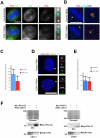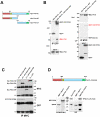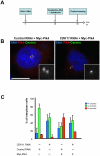CDK11(p58) is required for centriole duplication and Plk4 recruitment to mitotic centrosomes
- PMID: 21297952
- PMCID: PMC3031510
- DOI: 10.1371/journal.pone.0014600
CDK11(p58) is required for centriole duplication and Plk4 recruitment to mitotic centrosomes
Abstract
Background: CDK11(p58) is a mitotic protein kinase, which has been shown to be required for different mitotic events such as centrosome maturation, chromatid cohesion and cytokinesis.
Methodology/principal findings: In addition to these previously described roles, our study shows that CDK11(p58) inhibition induces a failure in the centriole duplication process in different human cell lines. We propose that this effect is mediated by the defective centrosomal recruitment of proteins at the onset of mitosis. Indeed, Plk4 protein kinase and the centrosomal protein Cep192, which are key components of the centriole duplication machinery, showed reduced levels at centrosomes of mitotic CDK11-depleted cells. CDK11(p58), which accumulates only in the vicinity of mitotic centrosomes, directly interacts with the centriole-associated protein kinase Plk4 that regulates centriole number in cells. In addition, we show that centriole from CDK11 defective cells are not able to be over duplicated following Plk4 overexpression.
Conclusion/significance: We thus propose that CDK11 is required for centriole duplication by two non-mutually-exclusive mechanisms. On one hand, the observed duplication defect could be caused indirectly by a failure of the centrosome to fully maturate during mitosis. On the other hand, CDK11(p58) could also directly regulate key centriole components such as Plk4 during mitosis to trigger essential mitotic centriole modifications, required for centriole duplication during subsequent interphase.
Conflict of interest statement
Figures





Similar articles
-
CDK11(p58) kinase activity is required to protect sister chromatid cohesion at centromeres in mitosis.Chromosome Res. 2014 Sep;22(3):267-76. doi: 10.1007/s10577-013-9400-x. Epub 2014 Jan 17. Chromosome Res. 2014. PMID: 24436071
-
NEK7 is essential for centriole duplication and centrosomal accumulation of pericentriolar material proteins in interphase cells.J Cell Sci. 2011 Nov 15;124(Pt 22):3760-70. doi: 10.1242/jcs.078089. Epub 2011 Nov 18. J Cell Sci. 2011. PMID: 22100915
-
Cep78 is a new centriolar protein involved in Plk4-induced centriole overduplication.J Cell Sci. 2016 Jul 15;129(14):2713-8. doi: 10.1242/jcs.184093. Epub 2016 May 31. J Cell Sci. 2016. PMID: 27246242
-
Role of Polo-like Kinases Plk1 and Plk4 in the Initiation of Centriole Duplication-Impact on Cancer.Cells. 2022 Feb 24;11(5):786. doi: 10.3390/cells11050786. Cells. 2022. PMID: 35269408 Free PMC article. Review.
-
The PLK4-STIL-SAS-6 module at the core of centriole duplication.Biochem Soc Trans. 2016 Oct 15;44(5):1253-1263. doi: 10.1042/BST20160116. Biochem Soc Trans. 2016. PMID: 27911707 Free PMC article. Review.
Cited by
-
Progesterone receptor membrane component-1 (PGRMC1) and PGRMC-2 interact to suppress entry into the cell cycle in spontaneously immortalized rat granulosa cells.Biol Reprod. 2014 Nov;91(5):104. doi: 10.1095/biolreprod.114.122986. Epub 2014 Sep 24. Biol Reprod. 2014. PMID: 25253729 Free PMC article.
-
Acto-myosin force organization modulates centriole separation and PLK4 recruitment to ensure centriole fidelity.Nat Commun. 2019 Jan 3;10(1):52. doi: 10.1038/s41467-018-07965-6. Nat Commun. 2019. PMID: 30604763 Free PMC article.
-
CDK-11-Cyclin L is required for gametogenesis and fertility in C. elegans.Dev Biol. 2018 Sep 1;441(1):52-66. doi: 10.1016/j.ydbio.2018.06.006. Epub 2018 Jun 7. Dev Biol. 2018. PMID: 29886128 Free PMC article.
-
CDK11(p58) kinase activity is required to protect sister chromatid cohesion at centromeres in mitosis.Chromosome Res. 2014 Sep;22(3):267-76. doi: 10.1007/s10577-013-9400-x. Epub 2014 Jan 17. Chromosome Res. 2014. PMID: 24436071
-
Polo-like kinases: structural variations lead to multiple functions.Nat Rev Mol Cell Biol. 2014 Jul;15(7):433-52. doi: 10.1038/nrm3819. Nat Rev Mol Cell Biol. 2014. PMID: 24954208 Review.
References
-
- Kellogg DR, Moritz M, Alberts BM. The centrosome and cellular organization. Annu Rev Biochem. 1994;63:639–674. - PubMed
-
- Nigg EA. Centrosome duplication: of rules and licenses. Trends Cell Biol. 2007;17:215–221. - PubMed
-
- Nigg EA. Centrosome aberrations: cause or consequence of cancer progression? Nat Rev Cancer. 2002;2:815–825. - PubMed
-
- Nigg EA. Origins and consequences of centrosome aberrations in human cancers. Int J Cancer. 2006;119:2717–2723. - PubMed
-
- Delattre M, Leidel S, Wani K, Baumer K, Bamat J, et al. Centriolar SAS-5 is required for centrosome duplication in C. elegans. Nat Cell Biol. 2004;6:656–664. - PubMed
Publication types
MeSH terms
Substances
LinkOut - more resources
Full Text Sources

